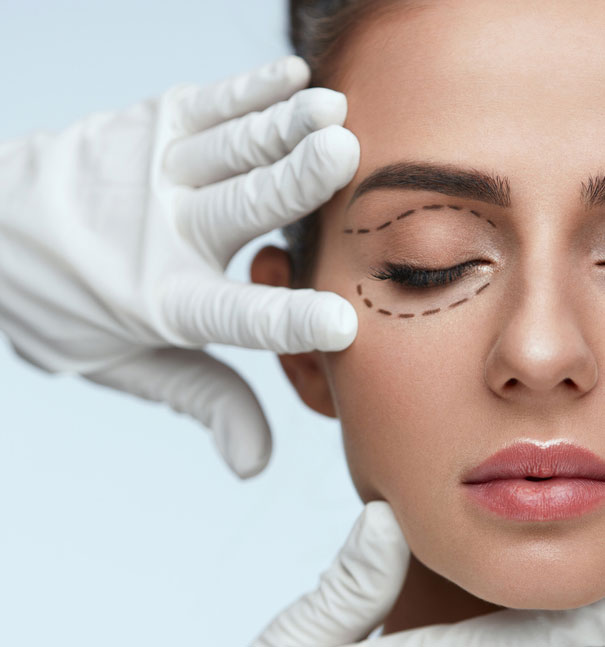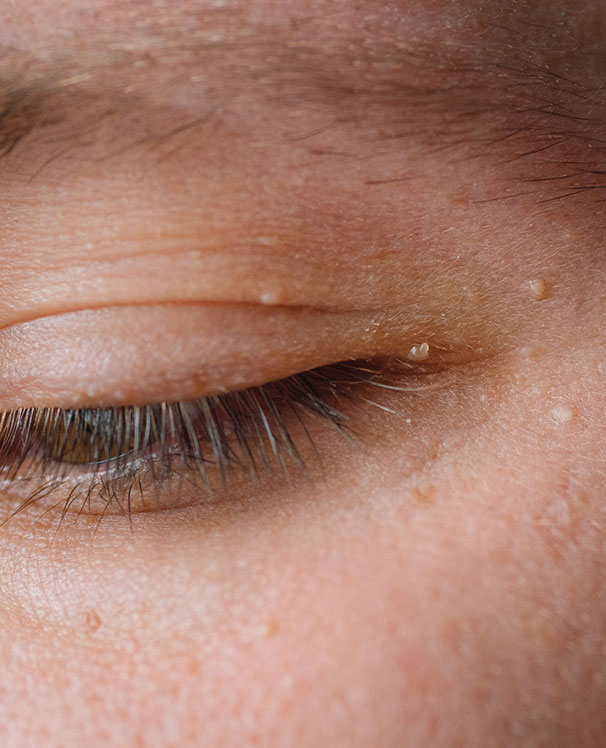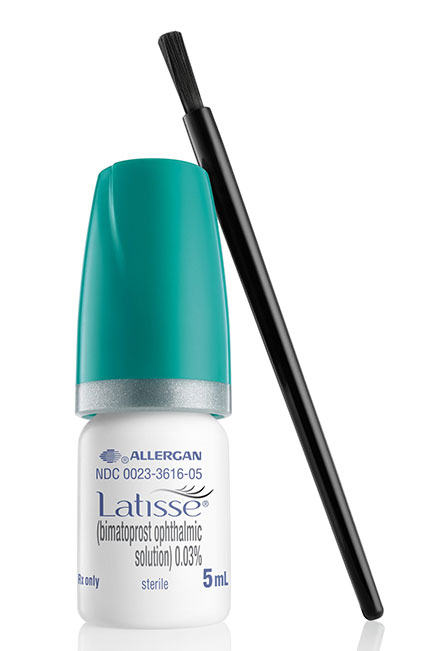Cosmetic Services
Blepharoplasty
Blepharoplasty (eyelid surgery) is a plastic surgery procedure for correcting sagging or drooping eyelids. The eyelid, because its skin is much thinner than that in other parts of the face, is often one of the first facial areas to exhibit signs of aging. Eyelids that sag or droop can affect peripheral vision, making daily activities such as driving more difficult. Blepharoplasty may become necessary when various factors, which include aging, sun damage, smoking and obesity, cause the muscles and tissue that support the eyelids to weaken.
Blepharoplasty tightens the eyelid's muscles and tissue, and removes excess fat and skin. Blepharoplasty eliminates the drooping of skin into the visual field, greatly improving peripheral vision. It is also performed for strictly cosmetic reasons.
FUNCTIONAL BLEPHAROPLASTY
If the eyelids begin sagging into the field of vision, a functional blepharoplasty may be required. The procedure may be covered by medical insurance if it is deemed medically necessary. A determination of how much vision is affected is done by checking the peripheral visual field with an instrument called the Humphrey Visual Field (HVF) Analyzer.
COSMETIC BLEPHAROPLASTY
Blepharoplasty can be performed on either the upper or lower eyelid, or on both, for cosmetic purposes. For a lower eyelid that needs fat rather than skin removed, a transconjunctival blepharoplasty is performed. During transconjunctival blepharoplasty, an incision is made inside the lower eyelid, so there are no visible scars, and the fat is removed. This procedure has no effect on vision, but results in a person's looking younger and more refreshed.
It is important for a patient to have realistic expectations before undergoing cosmetic blepharoplasty. Although the procedure can enhance appearance and improve self-confidence, it does not radically alter the face.
The best candidates for blepharoplasty are those who are in good overall health, do not smoke, do not have any serious eye conditions, and have healthy facial tissue and muscle.
People with eye disease, including glaucoma or retinal detachment, thyroid disorders, diabetes, cardiovascular disease or high blood pressure are not good candidates for blepharoplasty.
Blepharoplasty is typically performed as an outpatient procedure requiring local anesthesia and sedation. General anesthesia may be used for anxious patients. Patients can choose to have this procedure on their upper or lower eyelids, or both. The procedure can take anywhere from 45 minutes to 2 hours, depending on whether both the upper and lower eyelids are operated on.
If the upper eyelid is being operated on, an incision is typically made along its natural crease. Once the incision is made, fat deposits are repositioned or removed, muscles and tissue are tightened, and excess skin is removed. For the lower eyelid, an incision is usually made just below the lash line so that excess skin can be removed.
After the procedure, the incisions are closed with sutures, tissue glue or surgical tape, and usually loosely covered with gauze so the area can heal.
After blepharoplasty, patients may be advised to apply lubricating drops/ointment and cold compresses to aid in healing and minimize side effects. Most patients return to work within a few days to a week, but should avoid exercise and strenuous activities for at least 2 weeks. Stitches are usually removed after 3 or 4 days. Most swelling and other side effects typically subside within 2 weeks. Contact lenses and eye makeup may not be worn for 2 weeks after surgery. Patients are typically advised to wear dark sunglasses outside or in bright light for 2 weeks to protect their eyes from sun and wind.
Although there may be swelling and bruising around the surgical site, they will subside on their own, and the eyelids will improve in appearance for up to a year. Uncommon side effects include infection, reaction to anesthesia, and double or blurred vision. Eyes may be irritated and dry due to a temporary change in tear distribution. Side effects such as uneven healing and permanent scarring are rare but, if they occur, may require surgical correction. The scars from blepharoplasty are well-concealed, and usually fade with time until they are virtually undetectable. Although the eyelids are still subject to aging, blepharoplasty produces long-lasting results.


Eyelid Papilloma & Other Eyelid Tumors
An eyelid papilloma is a rounded growth that protrudes from the upper or lower eyelid. These are very common lesions that most frequently develop in middle-aged and older patients. Papillomas are most often benign, but in rare cases may be precancerous or malignant. Many patients opt to have these lesions removed even if they pose no medical risk for cosmetic purposes or because they are a source of discomfort.
The standard of treatment for most eyelid papillomas is surgical excision. Due to the proximity to the eye, especially if the lesion is near the margin, cutting it away is safer than most alternative procedures. After a local anesthetic is applied, your doctor will use surgical tools to remove the papilloma in its entirety. The procedure typically takes less than 30 minutes. Some patients experience mild bleeding or bruising at the treatment site afterward, but these usually resolve within a few days. Even after a complete excision, there is a possibility that the papilloma will eventually return.
Certain eyelid tumors may be malignant. Surgical excision of malignant eyelid tumors may require full-thickness eyelid resection and other complex oculoplastic procedures. Dr. Matthews as well trained in the surgical techniques and oculoplastic procedures that are required to safely and totally excise these lesions.
Latisse®
Full, natural-looking eyelashes can now be achieved through a prescription treatment called Latisse®. Latisse is the first and only eyelash treatment approved by the FDA to help grow longer, fuller and darker eyelashes and treat hypotrichosis, a condition that includes having inadequate or not enough eyelashes.
Latisse contains bimatoprost, an active ingredient that improves the appearance of your lashes and is often found in glaucoma medication. While the precise science of the treatment is not known, research suggests that the number of hairs and duration of the growth process are increased by bimatoprost.
This prescription medication is applied topically to the base of the eyelashes once a day, after makeup and contact lenses have been removed and any other skincare products have already been applied. While it does not replace mascara, Latisse offers an attractive complement to help further enhance full, long and beautiful lashes.
The results of Latisse are visible after 4 weeks, with full results appearing after 16 weeks. You can track the progress of your results through photographs. Side effects of Latisse are rare but may include itching, redness or dryness in the eye area. You should not use Latisse if you have an active eye infection or broken skin or irritated skin on the eyelid. Call your doctor today to find out if Latisse is right for you.
